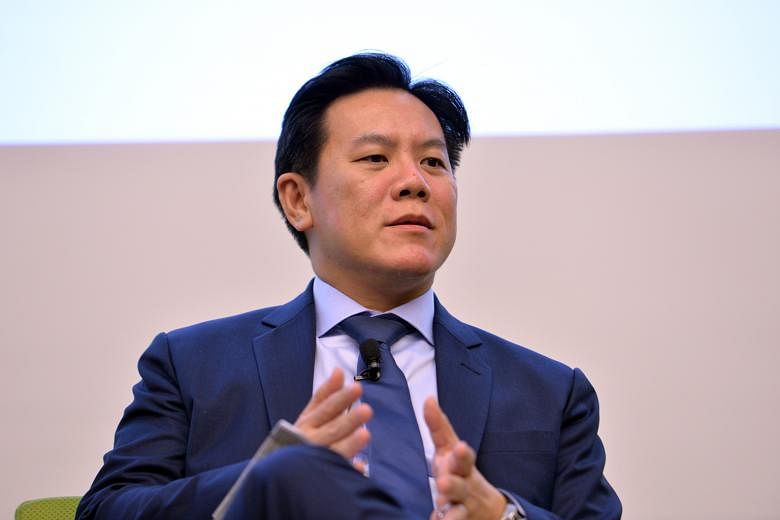Q. Data such as STI's dividend yield of 4.2 per cent and STI's 10-year 5.7 per cent annualised gain highlights the Singapore market's "mid- to long-term investability and high dividend yields". Can you elaborate?
A. The data illustrates the investability of our equity market - which goes through cycles but rewards equity investors a total return (inclusive of dividends) that is acknowledged to be higher than cash or bonds as asset classes, naturally because of the higher risk.
Domestic drivers may from time to time weigh more heavily in the short term, especially for less open markets. However, for more open markets such as Singapore, the overall macroeconomic environment and allocation of institutional portfolio flows play a more significant role. The strength of the Singapore market, which is underpinned by strong institutional support, can be seen by indexing markets at the low end of the last global crisis in 2008, with Singapore rapidly recovering first, then Asia broadly, followed by the US and Europe, then China eventually, and converging to pre-crisis levels before more recent corrections.
Q. There is a view that the STI historical data captures only a small number of listed companies and does not fully reflect the sluggishness that may exist for companies outside the STI. What is your view?
A. It is always difficult to conduct comparative market analysis. Index providers such as FTSE and MSCI have standards that ensure each domestic benchmark index is representative of the market it represents. Our STI is a three-way partnership with FTSE and Singapore Press Holdings, and today represents approximately 44 per cent of market capitalisation in Singapore and 70 per cent of daily turnover.
There are many other indices that measure different parts of the market, e.g., mid-cap FTSE, sectoral indices, which perform differently from the main benchmark. This is not unique to Singapore. Sector and segment vibrancy is determined by expectations of relative investor interest as well as the economic and corporate performance of the underlying companies.
In other markets, the long tails of hundreds, if not thousands, of listed companies in each market exhibit similar patterns - that of differential liquidity and cyclical performance - especially in the small- and micro-cap segments of stocks with limited institutional following and breadth of investors.
We are, of course, very keen for our whole market to be far more active and liquid... This involves attracting new and different sources of capital and investors. We have continually raised our efforts in investor education with partners such as SIAS, corporate profiling and access with brokers and banks, and also provide a uniquely Singapore free StockFacts service that covers all listed companies in Singapore.
Q. Although the Singapore market gives an above-average dividend yield, this could be partly due to weak prices. What is your view?
A. The STI component stocks do indeed reward their shareholders with the highest dividend yields in Asia, almost twice the Asian average. Compared to the next-highest dividend yield market which is Hong Kong, the STI trades at a price-to-earnings (PE) ratio of 11-12 versus 8-9 in HK - by that measure higher prices! It is simplistic to draw either conclusion as, after all, there are many types of investors, e.g., growth vs value, those who look for yield and capital gain, and those who trade and speculate - all these collectively come together and form the market price.
There are also differences between sectors. In growth sectors such as digital and healthcare, it reflects high PE ratios and generally lower dividend yields, and others such as REITs deliver high dividends and a mix of high to lower PEs.
Singapore's equity market has a variety of companies that cater to the different needs of every type of investor, across different expectations of yield, growth and value, and traders who have long or short views with different time horizons.
Q. Some investors view the Singapore market as one for those who prefer long-term stability. What is that position/market niche that SGX wants to fill, vis-a-vis regional peers?
A. This is a misconception. If you consider the variety of sectors and business models that SGX-listed securities represent, you will notice it comprises blue chips and growth companies (including top Singapore brands and international companies), as well as companies that are going through a tough patch of business cycle. What does this mean? Investors have choices - more conservative investors can invest in blue chips and buy-and-hold or dollar-cost average, while those who wish to take on more risks can invest in growth companies, and those who wish to trade the market can do so using a variety of fundamental and technical techniques on absolute or relative value basis.
If you look at stock exchanges worldwide, never will you find one that has only companies with prices only going up, or one that does not have companies that fail and get delisted. The Singapore market has historically strong sectors in finance, property, marine and offshore, mineral oil and gas, some of which are going through a tough macro environment, but there are also new sectors of healthcare, digital and consumer which offer growth and resilience. The strengths of our market are reflected in the presence of international institutional investors as well as international companies listing here.
We continue to focus on enhancing and innovating across our equity and debt fund-raising and trading platforms for companies, especially in sectors where Singapore has a competitive advantage and inherent strengths, to provide all segments of investors with the opportunity to participate in Asia and Singapore's economic growth, through SGX.
Just to highlight two of our sector strengths: The innovation in REITs and business trusts has enabled Singapore to develop regional leadership in a sector that attracts international listings and capital globally. This sector is already about 9 per cent of our market cap and about 14 per cent of daily turnover, a reflection of issuers and investors' appreciation for the regime, governance and trust here.
Our best-performing sector in 2015 - healthcare - includes healthcare REITs for investors looking for yield, dual-listed regional healthcare providers, and emerging biotech and biopharma for those who invest and trade for growth and healthy speculation. Some companies have more institutional following, and others attract venture funds and high-net-worth individuals, reflecting their growth prospects.
In addition, Catalist - our platform for growth companies - is now the board of choice for both fast-growing Singapore and international companies. Catalist features prominent home-grown brands such as Jumbo and Singapore O&G and, most recently, Secura, and has over the past three years supported $1.6 billion of fund-raising for Singapore SMEs.
As with most developed markets, we have a larger institutional investor base, including global sovereign wealth fund investors. We also have a broadening retail segment. Not all individual investors trade and speculate in small caps, some also trade and invest in blue chips, and increasingly so as the reduction in board lots to 100 has improved blue chips' accessibility to a wider group. Some investors buy and hold (as can be seen from the increase in CDP accounts with holdings) while others trade from time to time at different levels of frequency, be it through their banker, wealth manager or trading representatives (TRs) and, increasingly, online.
We still have far more to do, together with the entire industry - from issue managers and professionals supporting IPOs, to brokers, bankers, wealth managers, TRs, as well as listed companies - to raise awareness of our market and of investing, bring in new investors, capital and liquidity to make SGX a more vibrant equity market that we all collectively desire it to be.


